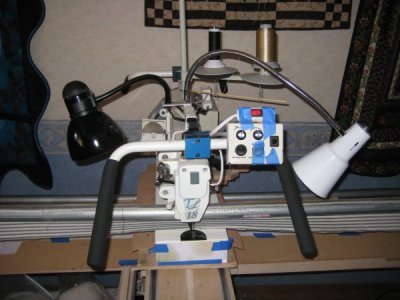Tin Lizzie in the Pirate household
Topics of Interest
In The Beginning
Introduced in 2006, the Tin Lizzie 18 longarm quilting machine was one of the first affordable longarm machines on the market. The original version (which is the one that I have) was a stretched, steel frame machine that was very basic. It has a speed regulator, a stitch regulator, an up-down needle position, uses an "M" (large) bobbin and that was about all. No extended list of bells-and-whistles BUT it was affordable.I bought mine in April 2006. As with any new machine, there was a learning curve to be mastered and a process in which the owner becomes acquainted with how to use Lizzie. It's an on-going process. :-)
The Tin Lizzie people are extremely responsive to customer comments and over the subsequent years, have produced variations to address those comments. My model is no longer being manufactured, as it has been replaced with a newer version that does have more bells-and-whistles.
I joined two Yahoo mailing lists for research and to learn from the wisdom and experience of others.
- One mailing list is Home Quilting Systems. It deals with ALL different types longarm and frame quilting systems. The information in their FILES sections is outstanding. It has a wealth of information on not only specific machines and frames but generic, all-purpose questions that are applicable to every set-up. I enthusiastically and emphatically heartily endorse all longarm owners to join this group. While you may ignore posts that deal with other manufacturers, there are many posts that are useful for everyone.
- The other mailing list is Tin Lizzie Longarm, a list specifically for Tin Lizzie. This list has also been extremely helpful and informational with Lizzie-specific items. While chatter about my model is dwindling, I find that there are still a number of owners of the original model, which make remaining a member of this list advantageous. The information in the FILES section is wonderful for Lizzie-specific situations.
Below are some topics that I had to deal with when setting up my Lizzie. One of the drawbacks of the early Lizzie was that there wasn't a whole lot of information or help on how to set Lizzie up. There were instructions that came with Lizzie, but they weren't terribly user-friendly. I did a LOT of Googling and looking at different web pages to find the information that was most helpful to me. My information may be useful for other longarm owners.
Now I will be the first to admit that there are times when buying a commercially available tool is EXACTLY what is needed and having the correct tool for the job absolutely makes life easier. Having said that, I'm a low-cost kinda person. :-) If I can create a work-around or figure out a low-cost way to solve a problem, I will go that route first to see how it works for me. Sometimes I'm successful and sometimes I'm not .. but if my low-cost version does work, then I have saved money that can be used elsewhere. (where? buying fabric, of course!)
Putting Leaders on the rails
 Each rail has a cloth leader. The top & bottom of the backing and top are pinned (or zippered) to the leaders to provide tension. The leader MUST be attached evenly and levely (is that a word?) to the rail or your quilt will NOT sit correctly and you will have tension problems.
Each rail has a cloth leader. The top & bottom of the backing and top are pinned (or zippered) to the leaders to provide tension. The leader MUST be attached evenly and levely (is that a word?) to the rail or your quilt will NOT sit correctly and you will have tension problems.
One aspect that was impressed upon me that even after you have correctly attached the leaders to the rails, you still need to attach your backing & top parallel to the rail or, once again, you will have tension problems. After reading about buying commercially available leaders ($$$), I read about using mattress ticking fabric. This is a very sturdy twill weave that has narrow stripes woven into the fabric. I found such fabric at my local Joann's and bought enough to go from one end of my rails to the other end, a total of 120" (about 3-1/3 yards). It isn't terribly expensive and I can't emphasize HOW EASY having those woven-in stripes have made my life!
I know that if I square up my top and backing, I can simply line up the raw edges of the fabric to any of the woven-in stripes and my top & backing absolutely, positively WILL BE square to the frame.
The leaders for each rail (take-up, backing and top) are different widths, although they are all obviously the same length (120" .. or the length of my rails). I know I followed directions from someplace for how wide to make the leader for each rail, but unfortunately, I can't find those instrutions in my notes. You are on your own for that. However, I have noticed, over time, that I wish I had made the leader on the lowest rail much wider. This is the rail that you load the top onto ... I would suggest that you make that leader at least 18"-24" wide. You may not always need that extra space but when you can't roll the quilt any further onto the take-up rail because you don't have any more top leader to extend ... you will wish you DID have more.
BUT once you have your leaders for each rail made, I followed the directions from Angie of the Home Quilting Systems (she's one of the co-mods), which is in that Yahoo Group's FILE section. The file is called "Leaders and Taping Leaders: Applying Tape and Leader Fabric to Rollers" and is *excellent*.
In the picture above, you see the leader (the striped mattress ticking fabric) attached to the take-up roller. Prior to attaching, I had marked with a Sharpie pen, the center of both the rail and the leader. Although those lines look offset in this pictures, that's only because of the angle I took the shot ... they really do line up. The center marking on the leader is important because THAT is where you are going to start pinning the center of your top or backing. :-)
Side tensioners
 Once you have your backing, batting and top loaded, you still have the problem of loose tension on the sides of the quilt. There are LOT of different techniques and tools you can use to provide an even side tension. Again, I'm a real cheap person :-) when it comes to buying stuff, so that if I can make something that works just as well as a store-bought item, I will go with the home made one.
Once you have your backing, batting and top loaded, you still have the problem of loose tension on the sides of the quilt. There are LOT of different techniques and tools you can use to provide an even side tension. Again, I'm a real cheap person :-) when it comes to buying stuff, so that if I can make something that works just as well as a store-bought item, I will go with the home made one.
The problem with clamps as side tensioners is that they grip the batting/backing in one specific place. When you pull on them, they pull in that one spot and if your batting/backing isn't sufficiently far enough away from the top, you will get tension "scallops" along the side.
Another problem with clamps is that Lizzie's carriage will bump into them when you get to the edge of the quilt. This will mess up your quilting. You need a low profile way of creating side tension.
An incredibly EASY way to create an even tension along the side of the quilt can be found on the Tin Lizzie Yahoo mailing list, in their FILES section .. the file is named "Side supports.doc Instructions for making a side support." It's a Word document authored by DJAZQuilter (Diana Jones). Thank you, Diana! You are AWESOME! It is made from fabric, folded into a triangle. Go get that file NOW!
In the picture above, you can see that I used ticking fabric left over from the leaders to create my side tensioners. Note that I have a nice distance from the quilt top to the edge of the batting/backing. I can use that space to test out my thread tension before I start quilting. The folded edge of the triangle (the hypotenuse) is pinned securely to the batting/backing and creates that all-important even tension along the side of the quilt. The pointed end of the triangle has a length of elastic sewn to it, then a length of grosgain ribbon sewn to the end of the elastic. The grosgrain ribbon is then wrapped around one of the knobs on the outside of my Lizzie frame to secure it. This is a totally AWESOME techique because 1) it's low cost and 2) it is completely FLAT ... Lizzie's hopping foot floats right over it; it never, ever is impeded during quilting.
Some people put Velcro on the end of the grosgrain ribbon and the corresponding Velcro on the outside of their frame. I elected not to do that because 1) I didn't have any sticky back Velcro and 2) I didn't want to staple non-sticky back Velco into Lizzie's frame.
Sidewinder and Lizzie

My Lizzie came with an incredibly clunky and OBNOXIOUS bobbin winder. I just hated it but it was all I had to wind the "M" bobbins. Then, a cute little stand-alone Sidewinder bobbin winder came on the market (circa 2007 or so?). I totally ignored it. It was aimed at the home sewer market and my Janome has an excellent bobbin winding mechanism on it.
Then I discovered that the Sidewinder WILL ACCEPT an "M" bobbin!
Oh. My. Goodness.
I could completely get rid of the Industrial Revolution era bobbin winder that I had! You can see in the picture that I have a spool of Bottom Line on the Sidewinder and this is how it is marketed for use. (Oh, and the pirate stickers? Because all the Sidewinders look exactly alike, if I ever take mine to a retreat or class, I want to be sure that I go home with "mine" ... and so I have stickers on my Sidewinder to identify it.) You can find the Sidewinder all over the place; I bought mine at Joann's and I was able to use a 40% off coupon! woo hoo!
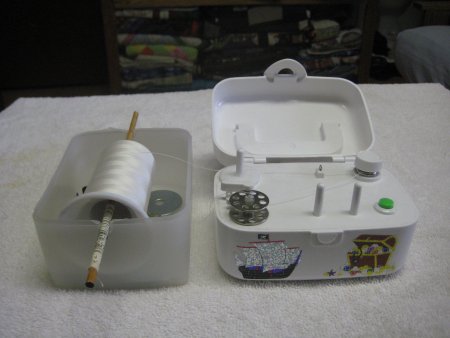 I have cones of thread for Lizzie; I don't normally use spools. The cones don't fit well on the spindle of the Sidewinder, so I came up with another home made work around. :-)
I have cones of thread for Lizzie; I don't normally use spools. The cones don't fit well on the spindle of the Sidewinder, so I came up with another home made work around. :-)
That white plastic box is a very small leftover food container. Goodness knows why I ever bought something so small ... we don't have leftovers in that amount! I put a small wooden dowel through the cone horizontally and placed the dowel on the plastic box. The cone now spins on the dowel as the Sidewinder pulls the thread from the cone. It works absolutely perfectly.
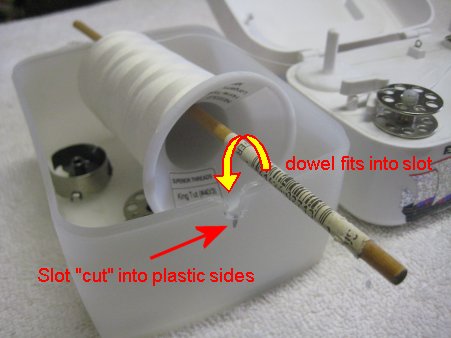 There was one small annoyance ... the wooden dowel kept slipping of the edges of the plastic box. It just so happens that I have a stencil cutter (a metal tip that gets VERY hot to cut/melt plastic). I used the tip of the stencil cutter to melt a slot in the center of the sides of the plastic box. The wooden dowel fits into these slots and is held firmly in place. The cones now spin on the dowel, which doesn't move at all yet is easily removed to change the cones. Addendum: this works so nicely that when I need to use spools, I put the spools on the dowel as well.
There was one small annoyance ... the wooden dowel kept slipping of the edges of the plastic box. It just so happens that I have a stencil cutter (a metal tip that gets VERY hot to cut/melt plastic). I used the tip of the stencil cutter to melt a slot in the center of the sides of the plastic box. The wooden dowel fits into these slots and is held firmly in place. The cones now spin on the dowel, which doesn't move at all yet is easily removed to change the cones. Addendum: this works so nicely that when I need to use spools, I put the spools on the dowel as well.
The plastic box also serves as a handy container for my extra bobbins and bobbin case.
Additionally, because sometimes I like to have things very organized (not often, but sometimes!), I found a plastic container to put both the Sidewinder and the plastic thread holder box into. This plastic contain fits perfectly on my bookshelf, where the Sidewinder lives. Putting both the Sidewinder and the thead holder box in another container makes sure that the box holding the thread doesn't accidently get moved off the shelf or too far away from the Sidewinder. 
Let There Be Light
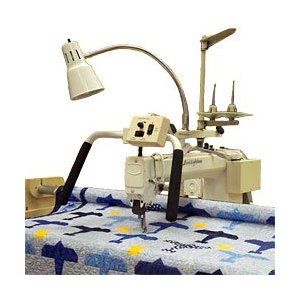 Originally, Lizzie came with one gooseneck lamp. The first modification I did was to put a daylight light bulb in it so the light was more natural looking. Regular light bulbs definitely looked very "yellow".
Originally, Lizzie came with one gooseneck lamp. The first modification I did was to put a daylight light bulb in it so the light was more natural looking. Regular light bulbs definitely looked very "yellow".
 Here's how the lighting on my Lizzie was ... the picture to the right shows up being *really* dark but that is because I deliberately left the overhead lights off for the picture. When working, I normally have the overhead lights on.
Here's how the lighting on my Lizzie was ... the picture to the right shows up being *really* dark but that is because I deliberately left the overhead lights off for the picture. When working, I normally have the overhead lights on.
The one lamp sufficed for quite a while but having light on only one side was an annoyance. True, the gooseneck lamp could be moved to whichever side you were quilting, but the other side remained in shadows .... and this bothered me. Additionally, the needle area was *always* in shadow. That was excessively annoying. I could have moved the lamp to center front so that the light would shine a little on both sides at once, but I sure did NOT like having the lamp right in front of my face.
Over the years, I pondered what could be done. My solution needed to be as low-cost as possible. I knew that some longarm machine frames had an overhead light bar. Those were huge and I didn't want one of those. Besides, buying a new frame was out of the question.
I thought of putting long, rectangular ceiling light fixtures on the walls at Lizzie's side. This would give me light from both sides at once. The downside was that not only would we need to buy the fixtures but they'd obviously need to be wired into the room. There was no way the cords could be concealed behind the drywall (since I knew we were not going to be doing major renovations for this project) and I really didn't want the cords to be visible on the wall. Also, it would require quite a bit of Mr. Pirate's time to do the electrical work, something that is in short supply right now ... so that idea wasn't going anywhere.
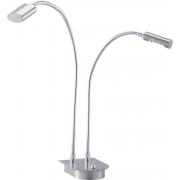 Then, it occurred to me ... what about a double gooseneck lamp? This was viable but these fixtures were a bit more expensive than I wanted to spend. It was time to think a bit more about how to solve this problem.
Then, it occurred to me ... what about a double gooseneck lamp? This was viable but these fixtures were a bit more expensive than I wanted to spend. It was time to think a bit more about how to solve this problem.
Then Mr. Pirate had a BRILLIANT idea ... instead of replacing the existing gooseneck lamp with a double, why not just ADD another gooseneck lamp? Well, .. duh. :-) I seemed to remember putting a gooseneck lamp away in storage but when I looked for it, it was nowhere to be found. I suspect it was taken to the thrift store some time ago.
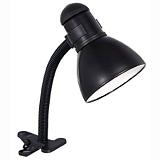 Over at the home improvement store, we found an inexpensive gooseneck lamp .. a clip-on style, in fact. After inspecting it, Mr. Pirate discovered that it could easily be taken apart so the clip-on part could be removed and the wiring would be accessible.
Over at the home improvement store, we found an inexpensive gooseneck lamp .. a clip-on style, in fact. After inspecting it, Mr. Pirate discovered that it could easily be taken apart so the clip-on part could be removed and the wiring would be accessible.
We needed a way of attaching gooseneck #2 to Lizzie. The original gooseneck lamp was threaded through the tubular frame bar. We wanted to keep Lizzie in as much of her original condition as possible and definitely did not want to go drilling holes through the tubular frame bar!
Fortunately, the solution was practically trivial. The tubular frame bar is attached to Lizzie's frame by two short tubular segments and long screws. One of these screws was *exactly* next to where gooseneck #1 was attached.
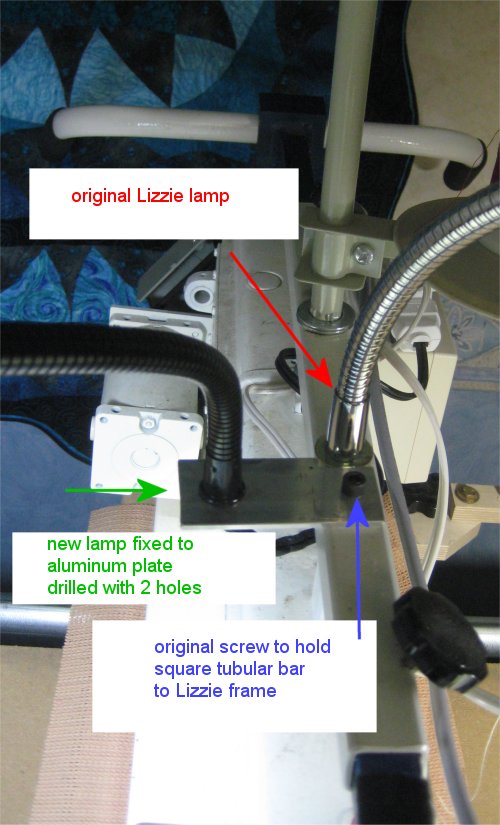 Mr. Pirate got a small rectangle aluminum (at the home improvement store) that was thick enough to be rigid, but not so thick that he couldn't drill through it. He drilled two holes through the aluminum ... one for gooseneck #2 and one for the screw.
Mr. Pirate got a small rectangle aluminum (at the home improvement store) that was thick enough to be rigid, but not so thick that he couldn't drill through it. He drilled two holes through the aluminum ... one for gooseneck #2 and one for the screw.
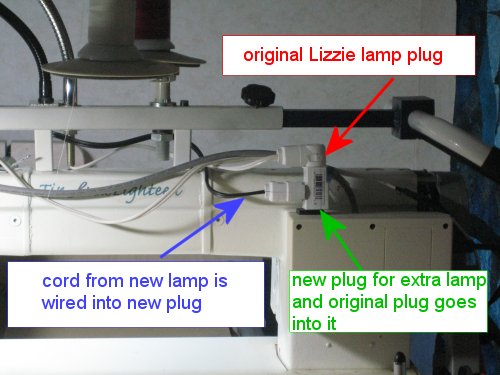 Now that the attachment problem was solved, we needed to figure out how to power gooseneck #2. Fortunately, this was another trivial solution! The plug for the original gooseneck lamp is a two-pronged plug that plugs into Lizzie's control box. What we needed (and found) is an additional plug that plugs into Lizzie's control box and also allows the original plug to plug into *it*.
Now that the attachment problem was solved, we needed to figure out how to power gooseneck #2. Fortunately, this was another trivial solution! The plug for the original gooseneck lamp is a two-pronged plug that plugs into Lizzie's control box. What we needed (and found) is an additional plug that plugs into Lizzie's control box and also allows the original plug to plug into *it*.
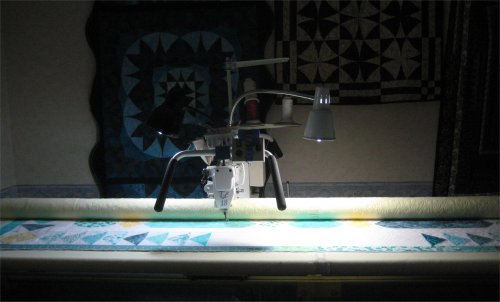 And NOW ... look at the difference with my two lamps! Wowsers! Mr. Pirate is BRILLIANT! I think he's definitely a keeper. :-)
And NOW ... look at the difference with my two lamps! Wowsers! Mr. Pirate is BRILLIANT! I think he's definitely a keeper. :-)
All totaled up, I think everything was under $20.00 ... and certainly solved my inadequate lighting problem magnificently. I love it. I love Mr. Pirate. :-)
